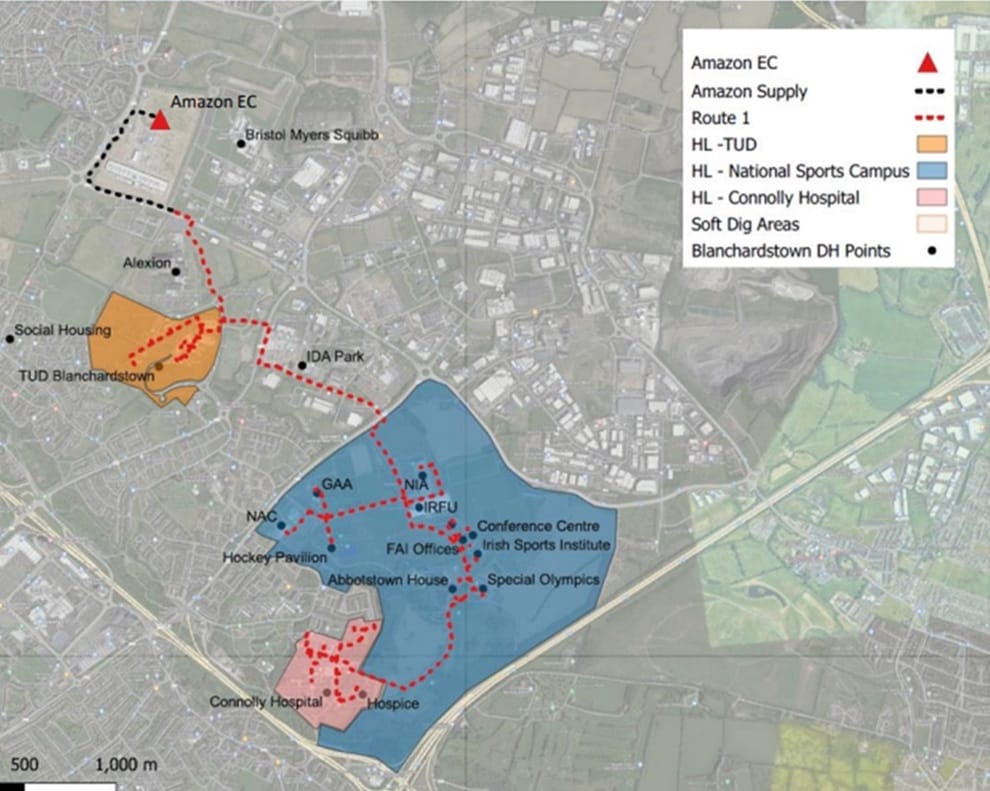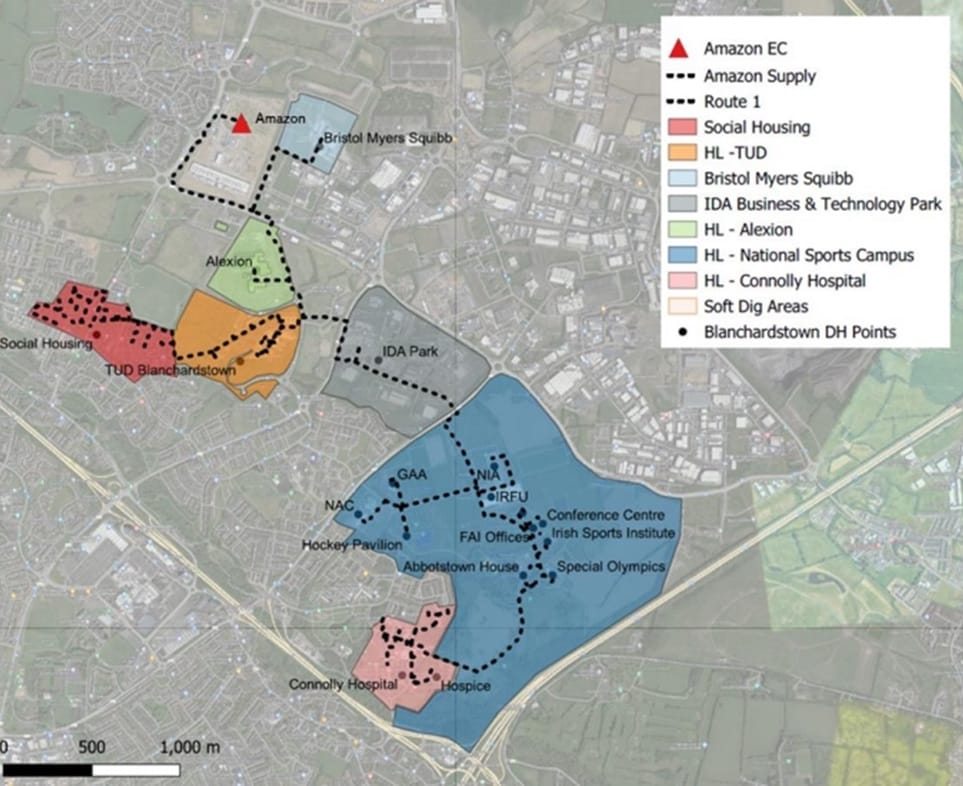What would become of the Civic Offices on Wood Quay if the council relocates?
After The Currency reported the idea of the council moving its HQ, councillors were talking about and thinking through the pros and cons and implications.
It’d take waste heat from data centres, and send it through a network of pipes to warm up surrounding businesses – and later homes, according to the plan.

Fingal County Council is still teasing out the possibility and economics of a district heating system in Blanchardstown, councillors learnt last week.
If approved by the council, the proposed scheme could pipe waste heat from data centres to warm buildings around the Dublin 15 suburb before the end of 2030, according to Neil O’Leary, an energy engineer with Codema, Dublin’s Energy Agency.
Among the first places to be heated would be Connolly Hospital and Technological University Dublin’s local campus, O’Leary said on 7 March at the council’s Blanchardstown/Mulhuddart/Castleknock-Ongar Area Committee.
The idea would be to connect up nearby social housing estates and pharmaceutical facilities by the end of the decade, said O’Leary.
But there isn’t a green light yet for it, John Daly, a senior engineer in the council’s Environment Division, told the meeting.
It could cost around €58 million, he said, and be five times the size of the country’s first such district heating system, in Tallaght.
Its progress depends on how much funding may come through from government grants and how much risk the council is willing to take to carry out the scheme, he said.
Rolling out district-heating schemes is part of the government’s plans to reduce carbon emissions. When it comes to heat, most buildings in Ireland still depend on oil- or gas-fuelled boilers.
While there’s a push to switch to electric heat pumps instead, there are advantages to lots of homes and businesses in an area clubbing together to get their heat from a central source, a strategy that is fairly common across continental Europe but rare in Ireland.
Codema first started to weigh up the idea of a district heating system – an insulated pipe network which delivers heat from a central, large plant to homes and businesses – for Blanchardstown in 2021, according to an agency annual report.
In May 2022, Equinix – which operates four data centres in west Dublin, including one in Blanchardstown – said in a press release that it would work with Codema on the heating system.
In February 2023, Codema published a feasibility report, according to its 2022 annual report – and Fingal County Council officials began to closely consider the project and how to proceed with it.
Codema has carried out an energy and CO2 assessment for the council, O’Leary told the committee on Thursday.
“As part of the analysis, we looked at what was the lowest cost, lowest carbon solution to decarbonising heat all over the county,” he said.
The analysis showed eight areas with high potential for district heating, including Balbriggan, Swords, Skerries and Blanchardstown, according to a presentation Codema representatives made to the council’s climate action committee in June 2023.
Blanchardstown was highlighted due to its high heat demand, population density and proximity to heat sources, O’Leary said. “What was particularly promising about Blanchardstown is there is a large cluster of data centres.”
These give off large amounts of low-grade waste heat, which can be captured in a district heating scheme, he said.
According to Data Center Map, a data centre research database, Blanchardstown has seven of 28 centres in County Dublin.
Codema’s proposed scheme would be rolled out in phases, beginning in 2025 and extending to beyond 2050.
Phase one would connect TU Dublin, Connolly Hospital and Sports Ireland, O’Leary said. “That’s about 10 kilometres of pipework, supplies about 34,500 megawatt hours of heat demand, which is the equivalent of 8,600 domestic heat pumps.”

Phase two would connect with nearby social homes, as well as pharmaceutical manufacturing industrial facilities run by Alexion and Bristol Myers Squibb, he said. “It requires an additional 5km of pipework.”

It is a flexible scheme with huge scope to expand in ensuing phases after 2030, O’Leary said.
The M50, south of the planned system, is something of a barrier to expansion, he said. But “There’s no reason that the scheme can’t expand beyond this point if roadworks were ever to occur.”
The typical lifespan of a district heating system is 50 years, he said. “So if you tot up the carbon savings that could occur over the entire lifetime, you’re talking about over half a million tonnes of CO2 saved.”
Capital expenditure required for the project would be in the region of €58 million, O’Leary said, with €42 million spent in the first phase and €16 million in the second.
Some of that could come from the government’s climate action fund and Support Scheme for Renewable Heat, he said. “The Tallaght scheme got about 50 per cent funding, so the intention would be to hopefully get something similar for this scheme.”
Outside of such grants, O’Leary said they would be looking for an investment of around €34.6 million.
With the feasibility study complete, the next step is for council officials to decide whether or not to proceed to procurement, according to a presentation shown to councillors on Thursday.
Once that decision is made, if it is a green light, Codema will begin to evaluate prospective developers with a view to awarding the tender for the scheme by December 2024, the presentation says.
It should take between two and four years to build, O’Leary said.
Fianna Fáil Councillor Howard Mahony asked why the scheme wasn’t being made available to individual homes rather than big institutions in the first phase. “Why the hospitals, why the university? Corduff is beside the university.”
Mahony said he would prefer to see it providing heat in homes first. “If public money is going into this, it should be going that way.”
Donna Gartland, Codema’s chief executive officer, said that connecting to big hospitals and universities is necessary to kickstart these schemes. “That’s what makes the system viable in order to connect the housing.”
The scheme in Tallaght began by taking waste heat from an Amazon data centre, and using it to help heat the South Dublin County Council County Hall and the TU Dublin campus there.
Daly, the council’s senior engineer, said the project is still at the feasibility stage. “There’s investigations going on. There’s quite a bit of assessment of the viability of the scheme.”
Whether it proceeds is dependent on the degree of funding acquired and the amount of risk the council is willing to undertake, he said. “So there isn’t a green light to definitely go ahead with this project.”